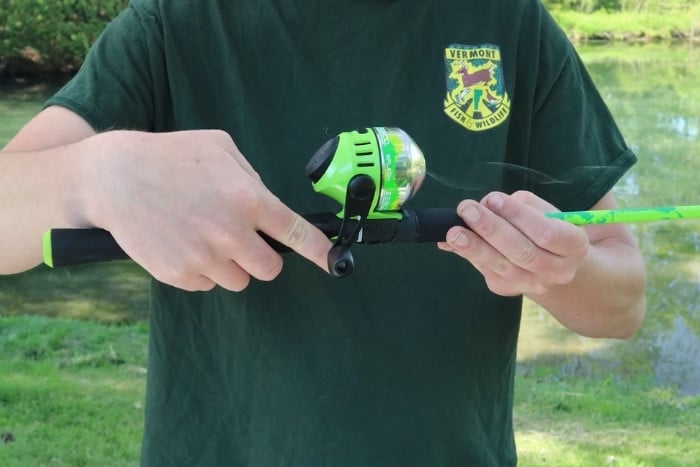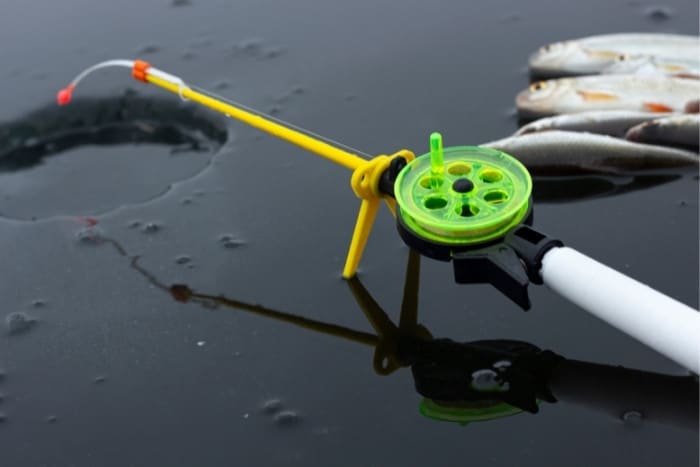With so many choices for ice fishing between spinning, baitcasting, or spin casting rods, and seemingly endless rod constructions, it’s challenging to figure out what type of rod is the best for ice fishing.
The best type of ice fishing rod will depend on your specific experience and needs, but a 26” light power, fast action spinning rod will be your best ice fishing rod if you are unsure of what you need. This time is great for beginners to learn how to use a spinning rod and jigging techniques.
Below we’ll break down the different types of rods you can use for ice fishing and what makes the best for each aspect of the rod.
What Are The Different Options For Ice Fishing Rods, And What’s The Best For Me
There is no more stressful experience for new anglers than picking out the right equipment, especially the fishing rod.
Even if you are an experienced summertime angler, picking up a rod for ice fishing can be a wildly different experience.
Thankfully we’ve broken up the different options below to help you decide what your best option is.
1. Spincasting Ice Fishing Rods
Spincasting ice fishing rods are the most common fishing rod for beginners due to their simple design and ease of use. These are the same style that most children’s rods are.
Spincasting rods have a button pressed to release the spool and let go when casting. The fishing line is enclosed, which makes them great for kids and beginners who might not yet understand spool control.
These rods are simple to operate but prone to breaking as the line gets tangled or the button mechanism fails.
Damage to spincast reels can happen when casting far and often, which is less of a problem when ice fishing.
Ice fishing for smaller species is excellent with a spincaster rod and for beginners who might be intimidated by a spinning rod.
When ice fishing, you’ll lose the benefits of spinning and baitcasting rods, as casting distance and accuracy matter a lot less.
The two most significant risks of using a spincast rod for ice fishing are poor construction, which can make them prone to breaking, and the chance of the internal mechanisms freezing.

2. Spinning Ice Fishing Rods
Spinning ice fishing reels come in many different sizes, with 500 being the smallest and 3000 and greater being considered larger sizes.
Reel sizes 500-2500 are the bread and butter of ice fishing and will work in just about any situation.
These combos will be lightweight enough to use all day without fatigue but enough to hold the appropriately sized line and bring in any fish.
Spinning reels are also the type that most people learn to fish with, either after a spincast rod or as their first style.
Spinning rods are easy to use and versatile in many situations and offer lots of control and line sensitivity.
Ice fishing is the perfect time to bring one out for people who are already comfortable with spinning rods and beginners who want to learn how to use a spinning rod.
The reason this is an excellent opportunity to teach someone how to use a spinning rod is you don’t need to cast very far, but you can still play with the different components.
Learning to flip the bail and pinch the line is easy for ice fishing, and they can even practice casting a few times above the ice.
Spinning rods, especially those with a low number of bearings and low gear ratio, are perfect for ice fishing and the best choice 90% of the time.
With a simple design, resistance to freezing, and few components to break, these rods will often be your best bet.
3. Baitcasting Ice Fishing Rods
Baitcasting ice fishing rods are the least common and likely the worst choice for most ice fishing applications.
While baitcasting rods are a popular choice for most other fishing styles, they are not great for ice fishing.
Baitcasting-specific ice fishing rods are few and far between and are often long (3 feet or more) and heavy for an ice fishing rod.
You can sometimes replace the reels on other combos with a baitcaster, but issues with the reel seat and guides often occur.
The main reason that most people prefer them is accurate casting over a distance and specific techniques like skipping a lure.
These benefits are lost when ice fishing because the bait is dropped down a hole in the ice instead of being cast out.
The other reason baitcasters aren’t great for ice fishing is because they perform better with heavier lines, especially braid, which doesn’t do well in ice fishing.
Too thick a line will scare line-sensitive fish, and the brain is likely to soak up water and freeze.
Some people prefer using baitcasting rods even for ice fishing due to familiarity, but for most anglers, using a spinning rod will be easier and work better in lower temperatures.
4. Rod Action And Power
Ice fishing rods will have three pieces of information that are all important to understand when selecting the best rod for your needs.
Length, usually in inches, is the easiest part to understand, followed by the power and action of the rod.
Action is based on the amount the rod will bend, separating the part of the rod that will bend and the backbone of the rod, which will stay straight when fighting a fish.
Extra-fast action implies the least amount of bend, while a slow action will have the most amount of bend.
The difference in fast action will vary from company to company, as there is no standard way to measure this.
Getting your hands on the rod will give you a better idea of the sensitivity, and in some brands, you may prefer their fast rods, while in others, you prefer extra-fast rods.
The faster the rod’s action, the more sensitive the rod will be, allowing you to detect the tiniest nibbles, and extra-fast to moderate-fast action rods are almost always the best option for ice fishing.
A fast-action rod will serve you well if you are a beginner. The rod’s power is how much force it takes for the rod to bend to its action rating.
The three power ratings most commonly used are light, medium, and heavy, although other, in-between, ultra-light, and medium-heavy ratings exist.
An ultra-light rod works well for smaller species, and a medium-heavy rod is a better choice for bass and walleye.
If you know what species you are targeting, choose a rod based on their size, but for general-purpose ice fishing, a medium power/fast action will be your best bet.

5. Technique Or Fish-Specific Rods
The other way that some manufacturers market their ice fishing rods is based on specific fish species. You might see one marketed towards panfish or another for walleye.
These rods are the same as other ice fishing rods, but the manufacturers made it easier to tell which fish they would be suitable to use.
These classifications are a great way for beginners to choose a rod based on the body of water they are fishing, without really knowing about power and action.
A rod can also be labeled for specific techniques such as a dead sticking or jigging specific rod. If you plan on using a particular method and see a rod marketed this way, that is easy to pick.
This rod type still refers to the power/action ratings but is an easy way to tell how a combo is best used.
Conclusion
Defining the “best” type of rod for ice fishing is difficult because personal preferences, targeted species, and different fishing methods all play a role in what type will work best.
For those new to ice fishing and the different types of rods, there are some general properties to look for that are beginner friendly and will work well in most conditions.
These are the best rods to use, with no other information. For beginners, a 26” spinning rod with fast action/light power will work for almost any scenario, allowing finesse and enough power to reel a fish in.
